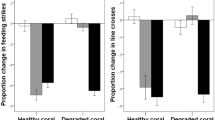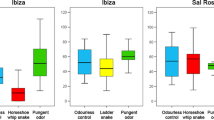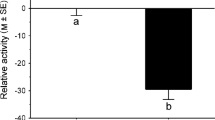Abstract
We studied two populations of damselfly larvae (Enallagma boreale): one population cooccurred with a predatory fish (northern pike, Esox lucius); the other did not. Damselflies that cooccurred with pike adopted antipredator behavior (reduced activity) in response to chemical stimuli from injured conspecifics, and to chemical stimuli from pike, relative to a distilled water control. Damselflies from an area where pike do not occur responded only to chemical stimuli from injured conspecifics. In a second set of experiments, we conditioned pike-naive damselflies to recognize and respond to chemical stimuli from pike with antipredator behavior. Damselfly larvae that were previously unresponsive to pike stimuli learned to recognize pike stimuli after a single exposure to stimuli from pike and injured damselflies or pike and injured fathead minnows (Pimephales promelas). The response to injured fathead minnows was not a general response to injured fish because damselfly larvae did not respond to chemical stimuli from injured swordtails (Xiphophorus helleri), an allopatric fish. Taken together, these data suggest a flexible learning program that allows damselfly larvae to rapidly acquire the ability to recognize local predation risk based on chemical stimuli from predators, conspecifics, and heterospecific members of their prey guild.
Similar content being viewed by others
REFERENCES
ALLEN, K. R. 1939. A note on the food of the pike (Esox lucius L.) in Windermere. J. Anim. Ecol. 8:72–75.
ATEMA, J., and STENZLER, D. 1977. Alarm substance of the marine mud snail, Nassarius obsoletus: Biological characterization and possible evolution. J. Chem. Ecol. 3:173–187.
BROWN, G. E., CHIVERS, D. P., and SMITH, R. J. F. 1995. Fathead minnows avoid conspecific and heterospecific alarm pheromone in the faeces of northern pike. J. Fish Biol. 47:387–393.
CHIVERS, D. P., and SMITH, R. J. F. 1994a. The role of experience and chemical alarm signalling in predator recognition by fathead minnows, Pimephales promelas. J. Fish. Biol. 44:273–285.
CHIVERS, D. P., and SMITH, R. J. F. 1994b. Fathead minnows, Pimephales promelas, acquire predator recognition when alarm substance is associated with the sight of unfamiliar fish. Anim. Behav. 48:597–605.
CHIVERS, D. P., and SMITH, R. J. F. 1994c. Intra-and interspecific avoidance of areas marked with skin extract from brook sticklebacks (Culaea inconstans) in a natural habitat. J. Chem. Ecol. 20:1517–1524.
CHIVERS, D. P., and SMITH, R. J. F. 1995. Fathead minnows (Pimephales promelas) learn to recognize chemical stimuli from high risk habitats by the presence of alarm substance. Behav. Ecol. 6:155–158.
CHIVERS, D. P., SISENDEN, B. D., and SMITH, R. J. F. 1995a. The role of experience in the response of fathead minnows (Pimephales promelas) to skin extract of Iowa darters (Etheostoma exile). Behaviour 132:665–674.
CHIVERS, D. P., BROWN, G. E., and SMITH, R. J. F. 1995b. Acquired recognition of chemical stimuli from pike, Esox lucius, by brook sticklebacks, Culaea inconstans (Osteichthyes, Gasterosteidae). Ethology 99:234–242.
CONVEY, P. 1988. Competition for perches between larval damselflies: The influence of perch use on feeding efficiency, growth rate and predator avoidance. Freshwater Biol. 19:15–28.
DIXON, S. M., and BAKER, R. L. 1988. Effects of size on predation risk, behavioural response to fish, and cost of reduced feeding in larval Ischnura verticalis (Coenagrionidae: Odonata). Oecologia 76:200–205.
DODSON, S. I., CROWL, T. A., PECKARSKY, B. L., KATS, L. B., COVICH, A. P., and CULP, J. M. 1994. Non-visual communication in freshwater benthos: An overview. J. N. Am. Benthol. Soc. 13:269–282.
GELOWITZ, C. M., MATHIS, A., and SMITH, R. J. F. 1993. Chemosensory recognition of northern pike (Esox lucius) by brook stickleback (Culaea inconstans): Population differences and the influence of predator diet. Behaviour 127:106–118.
GILES, N., and HUNTINGFORD, F. A. 1984. Predation risk and inter-population variation in antipredator behaviour in the three-spined stickleback, (Gasterosteus aculeatus L.). Anim. Behav. 32:26–275.
GÖZ, H. 1941. Über den Art-und Individualgeruch bei Fischen. Z. Vergl. Physiol. 29:723–730.
HARA, T. J. 1992. Overview and introduction. pp. 1–12, in T. J. Hara (ed.). Fish Chemoreception. Chapman and Hall, NY.
HEADS, P. A. 1985. The effect of invertebrate and vertebrate predators on the foraging movements of Ischnura elegans larvae (Odonata: Zygoptera). Freshwater Biol. 15:559–571.
HENRIKSON, B.-I. 1988. The absence of antipredator behaviour in the larvae of Leucorrhinia dubia (Odonata) and the consequences for their distribution. Oikos 51:179–183.
HEWS, D. K. 1988. Alarm response in larval western toads, Bufo boreas: Release of larval chemical by a natural predator and its effect on predator capture efficiency. Anim. Behav. 36:125–133.
JOHNSON, D. M. 1991. Behavioral ecology of larval dragonflies and damselflies. Trends Ecol. Evol. 6:8–13.
JOHANSSON, F., and SAMUELSSON, L. 1994. Fish-induced variation in abdominal spine length of Leucorrinia dubia (Odonata) larvae? Oecologia 100:74–79.
JOHNSTON, T. D. 1982. Selective costs and benefits in the evolution of learning, Adv. Study Behav. 12:65–106.
LAWLER, G. H. 1965. The food of the pike, Esox lucius, in Heming Lake, Manitoba. J. Fish. Res. Bd. Can. 22:1357–1377.
LIMA, S. L., and DILL, L. M. 1990. Behavioral decisions made under the risk of predation: A review and prospectus. Can. J. Zool. 68:610–640.
MAGURRAN, A. E. 1986. Predator inspection behaviour in minnow shoals: Differences between populations and individuals. Behav. Ecol. Sociobiol. 19:267–273.
MAGURRAN, A. E. 1989. Acquired recognition of predator odour in the European minnow (Phoxinus phoxinus). Ethology 82:216–223.
MATHIS, A., and SMITH, R. J. F. 1993a. Fathead minnows (Pimephales promelas) learn to recognize pike (Esox lucius) as predators on the basis of chemical stimuli from minnows in the pike's diet. Anim. Behav. 46:645–656.
MATHIS, A., and SMITH, R. J. F. 1993b. Intraspecific and cross-superorder responses to chemical alarm signals by brook stickleback. Ecology 74:2395–2404.
MATHIS, A., and SMITH, R. J. F. 1993c. Chemical alarm signals increase the survival time of fathead minnows (Pimephales promelas) during encounters with northern pike (Esox lucius). Behav. Ecol. 4:260–265.
MATHIS, A., CHIVERS, D. P., and SMITH, R. J. F. 1993. Population differences in responses of fathead minnows (Pimephales promelas) to visual and chemical stimuli from predators. Ethology 93:31–40.
MATITY, J. G., CHIVERS, D. P., and SMITH, R. J. F. 1994. Population and sex differences in antipredator responses of breeding fathead minnows (Pimephales promelas) to chemical stimuli from garter snakes (Thamnophis radix and T. sirtalis). J. Chem. Ecol. 20:2111–2121.
MC PEEK, M. A. 1989. Differential dispersal tendencies among Enallagma damselflies (Odonata) inhabiting different habitats. Oikos 56:187–195.
MC PEEK, M. A. 1990a. Determination of species composition in the Enallagma damselfly assemblages of permanent lakes. Ecology 71:83–98.
MC PEEK, M. A. 1990b. Behavioral differences between Enallagma species (Odonata) influencing differential vulnerability to predators. Ecology 71:1714–1726.
MENZEL, R., BICKER, G., CAREW, T. J., FISCHBACH, K.-F., GOULD, J. L., HEINRICH, B., HEISENBERG, M. A., LINDAUER, M., MARKL, H. S., QUINN, W. G., SAHLEY, C. L., and WAGNER, A. R. 1984. Biology of invertebrate learning: Group report, pp. 249–270, in P. Marler, and H. S. Terrace (eds.). The Biology of Learning: Report of the Dahlem Workshop on the Biology of Learning (1983). Springer-Verlag, Berlin.
MERRITT, R. W., and CUMMINS, K. W. 1984. An Introduction to the Aquatic Insects of North America, 2nd ed. Kendall/Hunt, IO.
MORIN, P. J. 1984. Odonata guild composition: Experiments with colonization history and fish predation. Ecology 65:1866–1873.
PIERCE, C. L., CROWLEY, P. H., and JOHNSON, D. M. 1985. Behavior and ecological interactions of larval Odonata. Ecology 66:1504–1512.
SEGHERS, B. H. 1974. Schooling behavior in the guppy (Poecilia reticulata): An evolutionary response to predation. Evolution 28:486–489.
SEGHERS, B. H., and MAGURRAN, A. E. 1995. Population differences in the schooling behaviour of the Trinidad guppy, Poecilia reticulata: Adaptation or constraint? Can. J. Zool. 73:1100–1105.
SIEGEL, S., and CASTELLAN, N. J. 1988. Nonparametric Statistics for the Behavioral Sciences, 2nd ed. McGraw-Hill, New York.
SMITH, R. J. F. 1992. Alarm signals in fishes. Rev. Fish Biol. Fish. 2:33–63.
SMITH, R. J. F., LAWRENCE, B. J., and SMITH, M. J. 1991. Cross-reactions to skin extract between two gobies, Asterropteryx semipunctatus and Brachygobius sabanus. J. Chem. Ecol. 17:2252–2259.
SNYDER, N. F. R. 1967. An alarm reaction of aquatic gastropods to intraspecific extract. Memoir 403, Cornell University Agricultural Station, New York College of Agriculture, Ithaca.
STENZLER, D., and ATEMA, J. 1977. Alarm response of the marine mud snail, Nassarius obsoletus: Specificity and behavioral priority. J. Chem. Ecol. 3:159–171.
WALKER, E. M. 1953. The Odonata of Canada and Alaska, Vol. 1. University of Toronto Press, Toronto, ON.
WARE, D. M. 1973. Risk of epibenthic prey to predation by rainbow trout (Salmo gairdneri). J. Fish. Res. Bd. Can. 30:787–797.
WISENDEN, B. D., CHIVERS, D. P., and SMITH, R. J. F. 1994. Risk-sensitive habitat use by brook stickleback (Culaea inconstans) in areas associated with minnow alarm pheromone. J. Chem. Ecol. 20:2975–2983.
WISENDEN, B. D., CHIVERS, D. P., BROWN, G. E., and SMITH, R. J. F. 1995a. The role of experience in risk assessment: Avoidance of areas chemically labelled with fathead minnow alarm pheromone by conspecifics and heterospecifics. Écoscience 2:116–122.
WISENDEN, B. D., CHIVERS, D. P., and SMITH, R. J. F. 1995b. Early warning in the predation sequence: A disturbance pheromone in Iowa darters (Etheostoma exile). J. Chem. Ecol. 21:1469–1480.
WRIGHT, D. I., and O'BRIEN, W. J. 1982. Differential location of Chaoborus larvae and Daphnia by fish: The importance of motion and visible size. Am. Midl. Nat. 108:68–73.
Author information
Authors and Affiliations
Rights and permissions
About this article
Cite this article
Wisenden, B.D., Chivers, D.P. & Smith, R.J.F. Learned Recognition of Predation Risk by Enallagma Damselfly Larvae (Odonata, Zygoptera) on the Basis of Chemical Cues. J Chem Ecol 23, 137–151 (1997). https://doi.org/10.1023/B:JOEC.0000006350.66424.3d
Issue Date:
DOI: https://doi.org/10.1023/B:JOEC.0000006350.66424.3d




